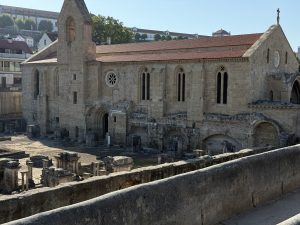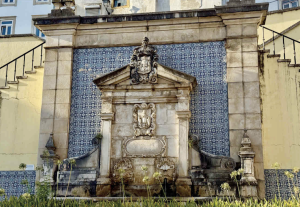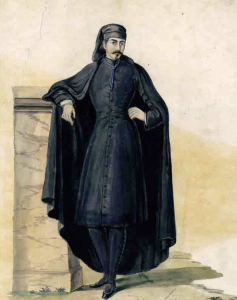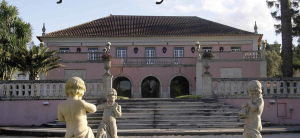Church
Igreja Rainha Santa Isabel
The Church of Queen Saint Isabel was consecrated in 1330 by the then Bishop of Coimbra.
Unusual at the time, the construction of three naves of identical height, vaulted in stone instead of the wooden roof then usual for mendicant orders, as well as the absence of a transept, allowed for a longer cloister.
The naves are lit by two rose windows at the ends of the central nave and by tall double windows in the side walls.
Its Romanesque-style design, with thick walls and buttresses, respects the layout of the temples of the Poor Clares in terms of its floor plan and elevations: three naves with seven bays, no transept, and a chevet with three chapels (the ones at the ends are quadrangular; the chancel is polygonal).
The apse and apsidioles have a polygonal interior, characteristic of the Gothic style.
Queen Saint Isabel, also known as Isabel of Aragon, was Queen of Portugal in the 14th century and is venerated as a saint by the Catholic Church.
She was known for her piety, charity and her work in promoting peace and harmony.
The Holy Queen died in 1336 and was buried in the Monastery of Santa Clara-a-Velha, in Coimbra.
The reliquary of Queen Saint Isabel is a piece of jewellery containing relics of the Holy Queen, and is housed in the Machado de Castro National Museum in Coimbra.
The piece is made of coral, gilded silver and enamel, and dates from the 14th century. The reliquary is one of the objects that belonged to Queen Isabel and was donated to the Monastery of Santa Clara-a-Velha.
After the canonisation of Saint Isabel in 1625 and the restoration of independence in Portugal in 1640, Dom João IV, on 12 December 1640, sponsored the construction of a new monastery to house the Poor Clares of the Monastery of Santa Clara-a-Velha, faithful custodians of the sacred remains of Queen Saint Isabel.
The church was built by the architect Mateus do Couto.
In the large apse that forms the chancel, there is a polychrome statue of Saint Elizabeth, by Teixeira Lopes (19th century).
Of particular note are the Baroque gilded woodcarvings and the 18th-century paintings depicting Franciscan saints.
Two important dates were marked in the same year: the consecration of the church dedicated to Saint Isabel of Portugal and the transfer of the incorrupt body of the Holy Queen to the tribune of the high altar.
In a grand procession from the old monastery, the body of Queen Saint Isabel was transferred and placed in a silver tomb on the high altar.
The beautiful original Gothic tomb of the Holy Queen, by Mestre Pero, made from a single stone, was commissioned by the queen herself and is located in the lower choir, as are the altarpieces from Santa Clara a Velha, with Mannerist carvings and paintings, polychrome wooden panels that narrate the story of her life. Next to the church and choir is the largest cloister in Portugal, after that of Cartuxa.
In 1910, the year the Republic was proclaimed in Portugal, the church, cloister and silver tomb of the Holy Queen were classified as a National Monument.






